Lauki Thepla, also known as Dudhi or Bottle Gourd Thepla, is a popular Gujarati flatbread made with whole wheat flour, grated bottle gourd, and a blend of spices for added flavor. This tasty and nourishing flatbread is commonly served for breakfast, weekend brunch, or packed in lunchboxes for a satisfying meal on the go.

At our home, I often prepare these soft and mildly spiced Lauki Theplas for my husband’s lunchbox. I usually pair them with a small container of fresh yogurt—it complements the thepla beautifully. If you’re making them ahead of time or packing them for later, don’t skimp on the oil while cooking. A generous amount of oil helps retain their softness and keeps them from drying out.
This recipe holds a regular place in Gujarati households and is a beloved part of their everyday meals. Among many variations, lauki thepla stands out as a light, healthy option made with bottle gourd and aromatic spices.
What to Serve With Lauki Thepla
Last weekend, I served these Lauki Thepla with a zingy homemade mango chutney. They also pair well with mango chunda, green chutney, or a simple pickle. Add a dollop of curd or masala chai on the side, and you’ve got yourself a comforting and satisfying meal.
What is Thepla?
We make thepla by kneading whole wheat flour with vegetables, yogurt, and spices into a soft, flavorful dough. It’s not the same as paratha, although they may look similar to some.
When to Make Lauki Thepla
I often whip these up for weekend brunches when we want something simple, filling, and healthy. They’re perfect for travel too, since they stay soft and tasty for hours if packed well.
So next time you’ve got a fresh bottle gourd in your kitchen, give this hearty and comforting recipe a try. Whether served hot off the tawa or packed for later, Lauki Theplas never disappoint!
Ingredients For Lauki Thepla:
- 1 cup grated Lauki (Bottle Gourd or Dudhi): Peel and grate fresh bottle gourd. Squeeze lightly to remove excess water, but don’t discard the juice—it can be used to knead the dough if needed.
- 1¼ cups Whole Wheat Flour (Chapati Atta): The base of the dough. Keep extra flour aside for dusting while rolling.
- 1 small Green Chili, finely chopped: Adjust the quantity based on your spice preference. Gives the theplas a mild heat.
- ½ teaspoon Fresh Ginger Paste (or grated/crushed): Adds a warm, zesty flavor and helps with digestion.
- 2 tablespoons finely chopped Coriander Leaves (Cilantro): Brings freshness and brightness to the dough.
- 1 tablespoon Kasuri Methi (Dried Fenugreek Leaves): Crushed slightly before adding. Adds depth and a slightly bitter, earthy flavor.
- ¼ teaspoon Turmeric Powder (Haldi): Provides a golden hue and subtle warmth.
- ½ teaspoon Red Chili Powder: Adds a touch of heat and a vibrant red hue to the theplas.
- ½ teaspoon Coriander Powder (Dhaniya Powder): Adds a gentle, citrusy flavor to balance the other spices.
- Salt to taste: Enhances all the other flavors. Add as per your preference.
- 1 tablespoon Oil (for dough): Helps make the dough smooth and pliable.
- 1–2 tablespoons Plain Yogurt (Curd), or as needed: Aids in binding the dough and ensures the theplas remain soft and tender. Adjust the quantity as needed, based on the water content released by the grated bottle gourd.
- Additional Oil for Shallow Frying: Add enough oil while frying, especially when making theplas for tiffin or later use, as it helps maintain their softness and prevents them from becoming dry.
Step-by-Step Instructions:
1) Combine Ingredients in a Mixing Bowl: In a large mixing bowl, add the whole wheat flour (atta), grated bottle gourd (lauki), finely chopped green chilies, freshly grated or crushed ginger, and chopped coriander leaves.
2) Add Spices and Oil: Sprinkle in the kasuri methi, turmeric powder, red chili powder, coriander powder, and salt as per taste. Add one tablespoon of oil to the mixture to enhance softness and flavor.

3) Mix Everything Thoroughly: Using clean hands, combine all the ingredients well. Set this mixture aside for about 10 minutes. This resting period allows the lauki to release its natural moisture, which will help in forming the dough.
4) Begin Kneading the Dough: After 10 minutes, check the moisture level. Start kneading the dough by adding a little plain yogurt (curd) at a time—begin with half a tablespoon and add more only if required. The amount of yogurt depends entirely on how much water your lauki has released.
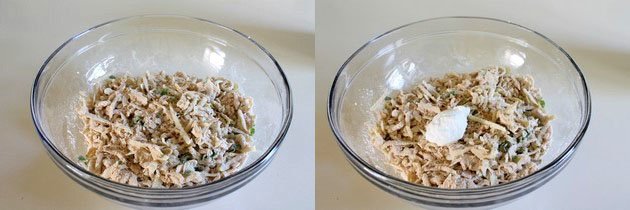
5) Achieve the Right Dough Consistency: The dough should feel soft and smooth—neither too sticky nor too hard. It should resemble the consistency of paratha dough. Avoid resting the dough, as lauki continues to release water, which may make it too soft or sticky if left aside for long.
6) Divide into Portions: Divide the kneaded dough into 8 equal portions. Shape each dough portion into a smooth, round ball by gently rolling it between your palms.
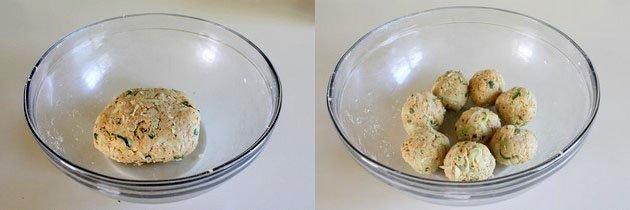
7) Dust with Flour: Lightly flatten one dough ball between your palms, then coat it with dry flour to prevent sticking while rolling.
8) Roll the Dough: With the help of a rolling pin, flatten the dough ball into a circular disc measuring approximately 5 to 6 inches across. If needed, dust with dry flour once or twice more—but avoid overusing it, as too much dry flour can make the theplas turn dry and tough after cooking.
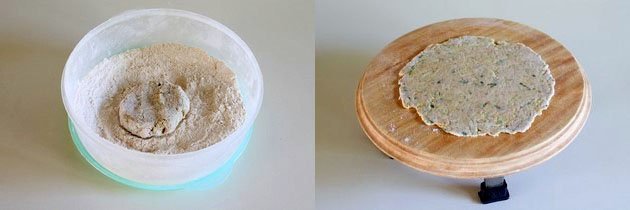
9) Preheat the Tawa or Skillet: Place a flat pan or tawa on medium heat. Once the pan is nicely heated, carefully place the rolled thepla onto the hot tawa or skillet.
10) Cook One Side Lightly: After a few seconds, small bubbles will appear on the surface. Flip it over—you’ll see faint brown spots on the underside.
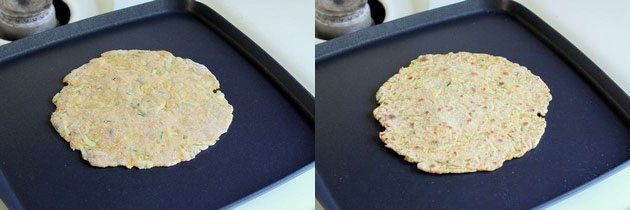
11) Partially Cook the Other Side: Let it cook on the other side for about 30 seconds. Next, add around ½ to 1 teaspoon of oil along the edges and lightly on the surface of the thepla.
12)Flip and Press Gently: Flip the thepla to the other side and softly press it with a spatula in circular movements to cook it evenly and help it puff slightly. This helps it cook evenly and puff slightly. Ensure there are no raw or doughy spots.
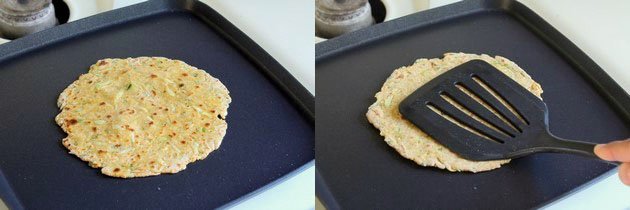
13) Apply More Oil and Flip Again: Brush or drizzle a bit more oil if needed, then flip it once more.
14) Final Press and Cook: Gently press again until the second side is cooked through and has golden-brown spots.

15) Remove and Keep Warm: After the thepla is completely cooked, take it off the tawa and transfer it to an insulated container to retain its warmth and softness. You may also enjoy it straight from the pan while it’s still hot and fresh.
16) Repeat for Remaining Dough: Continue the same rolling and cooking steps with the rest of the dough portions until all Lauki Theplas are prepared.
Expert Tips:
1) Mix Ingredients Before Resting: Start by combining the whole wheat flour, grated lauki, spices, herbs, and a bit of oil in a mixing bowl. Make sure to combine all the ingredients well before starting the kneading process. This helps release the natural moisture from the lauki, which you’ll utilize while forming the dough.
2) Allow the Mixture to Sit for 10 Minutes: After mixing, let the mixture rest for about 10 minutes. This resting period is important because the grated bottle gourd will start to release water. If you skip this step and knead the dough immediately, the lauki will continue releasing water afterward, making the dough overly soft and sticky later on.
3) Avoid Resting the Dough After Kneading: Unlike other doughs where resting improves texture, lauki dough should not be rested once kneaded. Bottle gourd contains a high amount of moisture, and if the dough is left sitting, it will become too loose and challenging to work with. This makes rolling difficult and can result in theplas that are tough and chewy.
4) Add Yogurt Gradually While Kneading: Use plain curd (yogurt) to bring the dough together, but add it in small amounts. Begin with half a tablespoon at a time and mix gently. The moisture released by the lauki may be sufficient on its own in some cases, so avoid adding all the yogurt at once. The key is to knead a soft yet non-sticky dough.
5) Aim for the Right Dough Consistency: The dough should be soft, smooth, and easy to handle—much like the consistency of dough used for making parathas. If it turns out too sticky, rolling will be messy, and if it’s too stiff, the theplas won’t turn out soft.
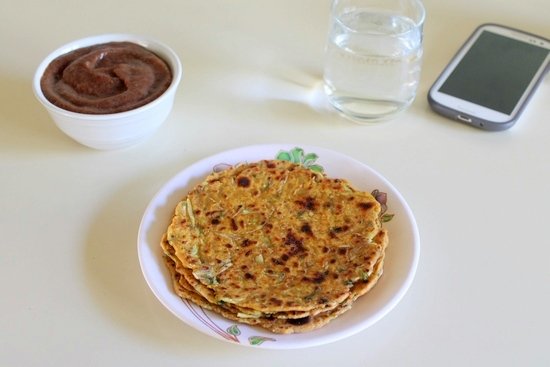
Serving suggestion:
Lauki Thepla is incredibly versatile and can be enjoyed in multiple ways. Enjoy it warm as a nourishing breakfast or light evening snack, perfectly complemented by a hot cup of masala tea. For a more filling option, pair it with a bowl of fresh yogurt, spicy chutney, tangy pickle, or cooling raita. These accompaniments not only elevate the flavors but also add a refreshing balance. Lauki theplas are also an excellent choice for lunchboxes—whether for kids or adults—since they stay soft for hours when cooked with enough oil. Their mild spice and soft texture make them a convenient and satisfying meal on the go.
